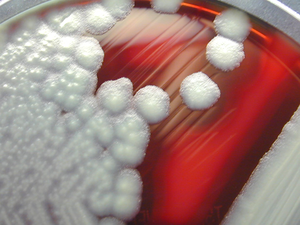We need you! Join our contributor community and become a WikEM editor through our open and transparent promotion process.
Bacillus cereus
From WikEM
Contents
Background
- Gram-positive, beta-hemolytic, rod-shaped bacterium
- Known for causing foodborne illness in humans, though some strains are probiotic
- Classically associated with "fried rice syndrome"
- 8-16 hour incubation time
Pathogenesis
- The emetic form is commonly caused by rice cooked for a time and temperature insufficient to kill any spores present, then improperly refrigerated. It can produce a toxin which is not inactivated by later reheating. This form leads to nausea and vomiting one to five hours after consumption. It can be difficult to distinguish from other short-term bacterial foodborne intoxications such as by Staphylococcus aureus.
- Bacillus foodborne illnesses occur due to survival of endospores when food is improperly cooked. Bacterial growth results in production of enterotoxins, one of which is heat- and acid-stable (pH 2 to 11); ingestion leads to two types of illness: diarrheal and emetic.
Clinical Features
Differential Diagnosis
Acute diarrhea
Infectious
- Viral (e.g. rotavirus)
- Bacterial
- Campylobacter
- Shigella
- Salmonella (nontyphi)
- Escherichia coli
- E. coli 0157:H7
- Yersinia enterocolitica
- Vibrio cholerae
- Clostridium difficile
- Parasitic
- Toxin
- Staphylococcus aureus
- Bacillus cereus
Noninfectious
- GI Bleed
- Appendicitis
- Mesenteric Ischemia
- Diverticulitis
- Adrenal Crisis
- Thyroid Storm
- Toxicologic exposures
- Antibiotic or drug-associated
Watery Diarrhea
- Enterotoxigenic E. coli (most common cause of watery diarrhea)[2]
- Norovirus (often has prominent vomiting)
- Campylobacter
- Non-typhoidal Salmonella
- Enteroaggregative E. coli (EAEC)
- Enterotoxigenic Bacteroides fragilis
Traveler's Diarrhea
Management
Primarily supportive/symptomatic treatment, as most patients recover.
Prognosis
- Most emetic patients recover within 6-24 hours
- In some rare cases, the toxin can be fatal.[3]
Table Overview
| ||||||||||||||||||||||||||||||||||||||||
See Also
References
- ↑ Kotiranta A, Lounatmaa K, Haapasalo M (2000). "Epidemiology and pathogenesis of Bacillus cereus infections". Microbes Infect 2 (2): 189–98. doi:10.1016/S1286-4579(00)00269-0. PMID 10742691.
- ↑ Marx et al. “Cholera and Gastroenteritis caused by Noncholera Vibrio Species”. Rosen’s Emergency Medicine 8th edition vol 1 pg 1245-1246.
- ↑ Takabe F, Oya M (1976). "An autopsy case of food poisoning associated with Bacillus cereus". ForensicSci 7 (2): 97–101.

